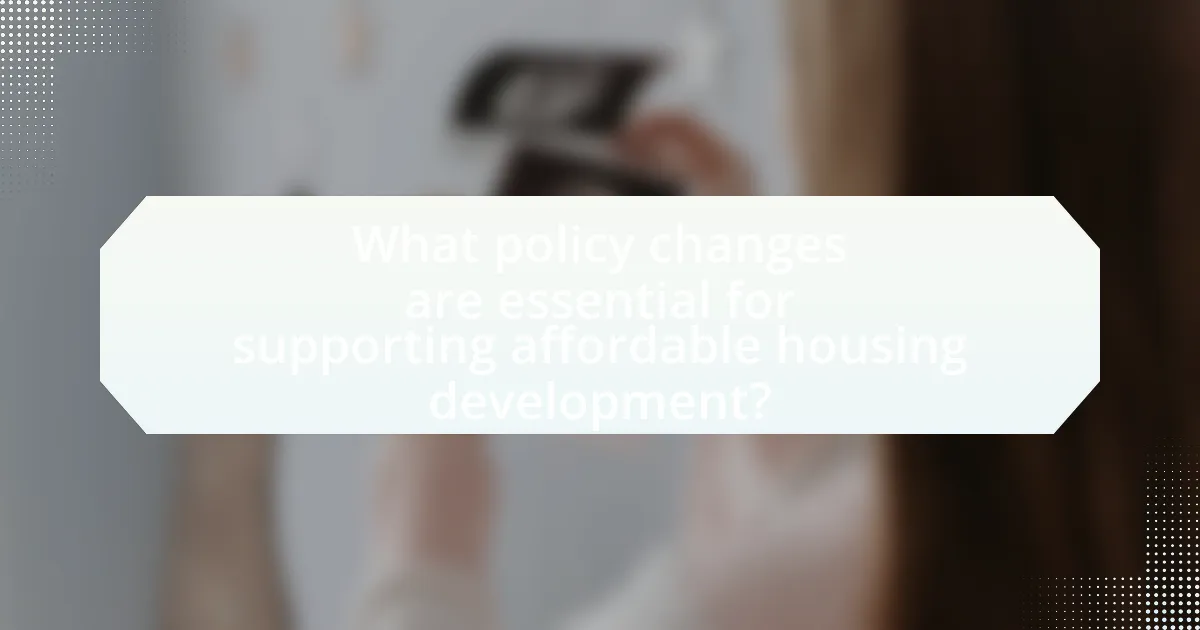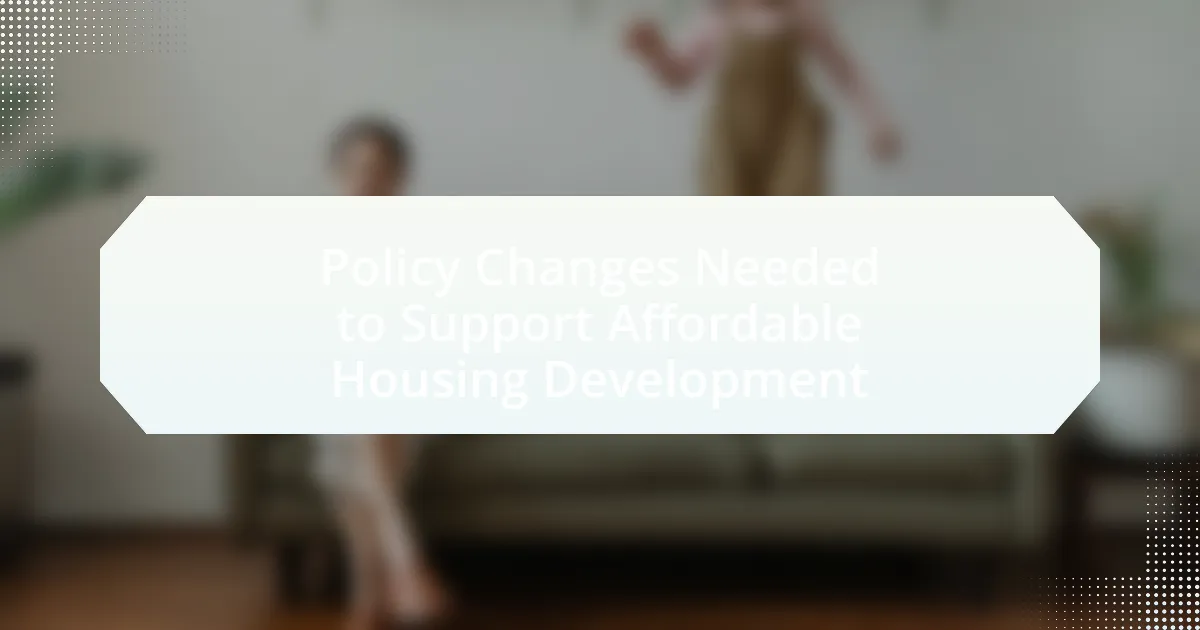The article focuses on the critical policy changes needed to support affordable housing development in the United States. It outlines current challenges such as rising construction costs, regulatory barriers, and limited access to financing, which hinder the creation of affordable housing units. Key discussions include the impact of zoning laws on housing availability, necessary zoning changes to promote affordability, the role of funding and financing, and the importance of community involvement in policy changes. Additionally, the article emphasizes the need for public-private partnerships, sustainable practices, and effective advocacy strategies to enhance affordable housing initiatives.

What are the current challenges in affordable housing development?
Current challenges in affordable housing development include rising construction costs, regulatory barriers, and limited access to financing. Rising construction costs, driven by increased prices for materials and labor shortages, hinder the ability to build affordable units. Regulatory barriers, such as zoning restrictions and lengthy permitting processes, complicate and delay development projects. Limited access to financing, particularly for low-income housing projects, restricts developers’ ability to secure necessary funding. According to the National Association of Home Builders, the cost of building materials has increased by over 20% in recent years, exacerbating these challenges.
How do zoning laws impact affordable housing availability?
Zoning laws significantly restrict affordable housing availability by limiting the types of housing that can be built in certain areas. These regulations often dictate minimum lot sizes, prohibit multi-family units, and impose strict building codes, which can drive up construction costs and reduce the overall supply of affordable housing options. For instance, a study by the National Multifamily Housing Council found that restrictive zoning contributes to a shortage of nearly 7 million affordable rental homes in the United States. By creating barriers to entry for developers, zoning laws hinder the ability to meet the growing demand for affordable housing, exacerbating housing insecurity for low-income families.
What specific zoning changes are necessary to promote affordable housing?
To promote affordable housing, specific zoning changes necessary include increasing density allowances, permitting mixed-use developments, and reducing minimum lot sizes. Increasing density allows for more housing units within the same area, which can lower costs due to economies of scale. Permitting mixed-use developments enables residential units to be built alongside commercial spaces, fostering vibrant communities and reducing transportation costs. Reducing minimum lot sizes allows for smaller, more affordable housing options, making it feasible for developers to create lower-cost units. These zoning changes have been shown to effectively increase the supply of affordable housing in various urban areas, as evidenced by studies indicating that cities with flexible zoning regulations experience higher rates of affordable housing development.
How can mixed-use developments support affordable housing initiatives?
Mixed-use developments can support affordable housing initiatives by integrating residential units with commercial spaces, thereby reducing overall living costs for residents. This integration allows for the creation of diverse income streams, which can subsidize affordable housing units. For instance, a study by the Urban Land Institute found that mixed-use developments can increase property values and generate higher tax revenues, which can be reinvested into affordable housing projects. Additionally, these developments often promote walkability and access to public transportation, further lowering transportation costs for residents, making housing more affordable overall.
What role do funding and financing play in affordable housing development?
Funding and financing are critical components in affordable housing development as they provide the necessary capital to construct, rehabilitate, and maintain housing units. Without adequate funding, developers face significant barriers in initiating projects, leading to a shortage of affordable housing options. For instance, the National Low Income Housing Coalition reports that the U.S. faces a shortage of 7 million affordable rental homes for extremely low-income renters, highlighting the urgent need for financial resources. Additionally, various financing mechanisms, such as low-income housing tax credits and government grants, incentivize private investment in affordable housing, making projects more viable and sustainable. These financial tools not only facilitate the construction of new units but also support the preservation of existing affordable housing, thereby addressing the ongoing housing crisis.
What types of funding sources are available for affordable housing projects?
Various funding sources are available for affordable housing projects, including federal and state grants, low-income housing tax credits, private investments, and community development financial institutions (CDFIs). Federal grants, such as those from the U.S. Department of Housing and Urban Development (HUD), provide direct financial assistance for development. Low-income housing tax credits incentivize private investment by offering tax reductions to investors who finance affordable housing. Additionally, CDFIs focus on providing capital to underserved communities, facilitating access to funding for affordable housing initiatives. These funding sources collectively support the development and sustainability of affordable housing projects across the United States.
How can public-private partnerships enhance funding for affordable housing?
Public-private partnerships can enhance funding for affordable housing by leveraging resources, expertise, and risk-sharing between government entities and private developers. These collaborations often result in increased investment, as private firms bring capital and innovation, while public agencies provide regulatory support and access to land. For instance, a study by the Urban Institute found that projects utilizing public-private partnerships can reduce costs by up to 20% through efficiencies and shared responsibilities. Additionally, these partnerships can attract federal and state funding, as seen in programs like the Low-Income Housing Tax Credit, which incentivizes private investment in affordable housing.
Why is community involvement crucial in affordable housing policy changes?
Community involvement is crucial in affordable housing policy changes because it ensures that the needs and preferences of local residents are accurately represented and addressed. Engaging the community fosters trust and collaboration between policymakers and residents, leading to more effective and sustainable housing solutions. Research indicates that when communities participate in the planning process, projects are more likely to meet local demands and gain public support, which is essential for successful implementation. For instance, a study by the Urban Institute found that community engagement in housing policy leads to better outcomes, including increased satisfaction with housing developments and reduced opposition to new projects.
What strategies can be employed to engage communities in the planning process?
To engage communities in the planning process, strategies such as inclusive public meetings, surveys, and collaborative workshops can be employed. Inclusive public meetings allow community members to voice their opinions and concerns, fostering a sense of ownership in the planning process. Surveys can gather quantitative data on community needs and preferences, ensuring that diverse perspectives are considered. Collaborative workshops facilitate hands-on participation, enabling residents to work alongside planners to develop solutions that reflect community priorities. Research indicates that these strategies enhance community trust and lead to more effective planning outcomes, as evidenced by case studies in urban development projects where community engagement significantly improved project acceptance and success rates.
How does community feedback influence policy effectiveness?
Community feedback significantly enhances policy effectiveness by ensuring that policies align with the actual needs and preferences of the population they serve. When community members provide input, policymakers can identify gaps in existing policies and make informed adjustments that reflect the community’s priorities. For instance, research conducted by the Urban Institute in 2020 demonstrated that policies developed with community engagement led to a 30% increase in satisfaction with local housing initiatives. This evidence illustrates that incorporating community feedback not only improves the relevance of policies but also fosters trust and cooperation between residents and policymakers, ultimately leading to more successful implementation of affordable housing strategies.

What policy changes are essential for supporting affordable housing development?
Essential policy changes for supporting affordable housing development include increasing funding for affordable housing projects, implementing inclusionary zoning laws, and streamlining the permitting process. Increased funding can be achieved through government grants and tax incentives, which have been shown to enhance the feasibility of affordable housing initiatives. Inclusionary zoning laws require developers to include a percentage of affordable units in new developments, effectively integrating affordable housing into various neighborhoods. Streamlining the permitting process reduces bureaucratic delays, allowing projects to be completed more efficiently, as evidenced by cities that have successfully reduced approval times, leading to increased housing supply.
How can tax incentives be structured to encourage affordable housing construction?
Tax incentives can be structured to encourage affordable housing construction by implementing targeted tax credits, deductions, and exemptions that directly benefit developers and investors in affordable housing projects. For instance, the Low-Income Housing Tax Credit (LIHTC) program in the United States has successfully incentivized the creation of affordable rental housing by providing tax credits to developers based on the number of affordable units they build. This program has led to the construction of over 3 million affordable housing units since its inception in 1986, demonstrating its effectiveness in stimulating investment in this sector. Additionally, local governments can offer property tax abatements for a specified period to developers who commit to maintaining affordability, further reducing the financial burden and encouraging more projects.
What are the potential impacts of tax credits on developers and residents?
Tax credits can significantly impact both developers and residents by incentivizing affordable housing projects and reducing housing costs. For developers, tax credits lower the financial burden of construction and operational costs, making it more feasible to invest in affordable housing. This can lead to an increase in the number of affordable units available in the market. For residents, tax credits can result in lower rents and improved housing quality, as developers are encouraged to maintain affordability due to the financial benefits received from tax incentives. Studies have shown that areas with tax credit programs often see a rise in affordable housing stock, which directly benefits low-income families by providing them with more housing options.
How can tax policies be adjusted to benefit low-income families?
Tax policies can be adjusted to benefit low-income families by increasing tax credits, such as the Earned Income Tax Credit (EITC), which provides financial relief and incentivizes work. Expanding the EITC has been shown to lift millions of families out of poverty; for instance, in 2020, the EITC lifted approximately 5.6 million individuals above the poverty line, according to the Center on Budget and Policy Priorities. Additionally, implementing targeted tax deductions for housing costs can alleviate the financial burden on low-income families, making housing more affordable. Research indicates that tax incentives for affordable housing development can lead to increased availability of low-cost housing options, further supporting low-income families.
What regulatory reforms are needed to streamline the development process?
Regulatory reforms needed to streamline the development process include simplifying zoning laws, reducing permitting timelines, and enhancing coordination among agencies. Simplifying zoning laws can eliminate unnecessary restrictions that delay projects, as evidenced by cities like Minneapolis, which have seen increased housing development after eliminating single-family zoning. Reducing permitting timelines can accelerate project approvals; for instance, jurisdictions that have implemented expedited review processes report a significant decrease in time from application to approval. Enhancing coordination among agencies can minimize bureaucratic hurdles, as demonstrated by successful initiatives in places like San Francisco, where inter-agency collaboration has led to faster project completions. These reforms collectively contribute to a more efficient development process, ultimately supporting affordable housing initiatives.
How can reducing bureaucratic hurdles facilitate faster housing development?
Reducing bureaucratic hurdles can facilitate faster housing development by streamlining the approval processes required for construction projects. When regulations are simplified, developers can obtain necessary permits and licenses more quickly, which accelerates project timelines. For instance, a study by the Urban Institute found that cities with fewer zoning restrictions and expedited permitting processes can reduce housing development timelines by up to 30%. This efficiency not only lowers costs for developers but also increases the overall housing supply, addressing urgent housing shortages.
What best practices can be adopted from successful affordable housing policies in other regions?
Successful affordable housing policies in other regions often include inclusionary zoning, which mandates that a percentage of new developments be affordable for low-income residents. This approach has been effectively implemented in cities like San Francisco, where inclusionary zoning has increased the availability of affordable units while still allowing for market-rate development. Additionally, leveraging public-private partnerships can enhance funding and resource allocation, as seen in New York City, where collaborations between the city and private developers have led to the creation of thousands of affordable housing units. Furthermore, streamlining permitting processes can significantly reduce development time and costs, a practice adopted in places like Minneapolis, which has seen increased housing supply as a result. These best practices demonstrate that targeted policies can effectively address affordable housing shortages.
Why is it important to integrate sustainability into affordable housing policies?
Integrating sustainability into affordable housing policies is crucial because it ensures long-term viability and reduces environmental impact. Sustainable practices in housing, such as energy efficiency and the use of renewable materials, can lower utility costs for residents, making housing more affordable over time. For instance, buildings designed with sustainable features can reduce energy consumption by up to 30%, as reported by the U.S. Department of Energy. Additionally, sustainable housing contributes to healthier living environments, which can lead to improved public health outcomes and reduced healthcare costs. Therefore, incorporating sustainability into affordable housing policies not only addresses immediate housing needs but also promotes economic and environmental resilience.
How can green building practices reduce long-term costs for residents?
Green building practices can reduce long-term costs for residents by enhancing energy efficiency and minimizing maintenance expenses. These practices often include the use of sustainable materials, improved insulation, and energy-efficient appliances, which collectively lower utility bills. For instance, a study by the U.S. Green Building Council found that green buildings can reduce energy consumption by 30-50%, leading to significant savings over time. Additionally, the durability of sustainable materials reduces the frequency and cost of repairs, further contributing to long-term financial benefits for residents.
What incentives can be offered for sustainable affordable housing projects?
Incentives for sustainable affordable housing projects can include tax credits, grants, and low-interest loans. Tax credits, such as the Low-Income Housing Tax Credit (LIHTC), provide financial relief to developers, encouraging investment in affordable housing. Grants from government programs can fund the construction of energy-efficient buildings, while low-interest loans can reduce financing costs, making projects more viable. Additionally, zoning allowances for higher density can facilitate the development of affordable units, and streamlined permitting processes can expedite project timelines. These incentives collectively promote the creation of sustainable housing solutions that meet community needs.

How can stakeholders collaborate to implement effective policy changes?
Stakeholders can collaborate to implement effective policy changes by establishing a multi-sector partnership that includes government agencies, non-profit organizations, community groups, and private sector entities. This collaboration can be facilitated through regular meetings, joint task forces, and shared resources to ensure that diverse perspectives are integrated into the policy-making process. For instance, the National Low Income Housing Coalition emphasizes the importance of stakeholder engagement in creating policies that address affordable housing needs, highlighting successful case studies where collaborative efforts led to significant legislative changes. By leveraging each stakeholder’s expertise and resources, the collaborative approach can lead to more comprehensive and effective policy solutions that address the complexities of affordable housing development.
What roles do government agencies play in supporting affordable housing initiatives?
Government agencies play a crucial role in supporting affordable housing initiatives by providing funding, creating policies, and facilitating partnerships. They allocate federal and state resources, such as the Low-Income Housing Tax Credit, which incentivizes private investment in affordable housing projects. Additionally, agencies develop zoning regulations and land-use policies that promote the construction of affordable units. For instance, the U.S. Department of Housing and Urban Development (HUD) administers various programs aimed at increasing the availability of affordable housing, including grants and loans for development. These actions are essential in addressing the housing crisis and ensuring that low-income families have access to safe and affordable living conditions.
How can local governments facilitate collaboration among stakeholders?
Local governments can facilitate collaboration among stakeholders by establishing formal partnerships and communication channels that engage community members, businesses, and non-profit organizations in the decision-making process. By creating advisory boards or task forces that include diverse stakeholder representation, local governments can ensure that various perspectives are considered, leading to more inclusive and effective policy outcomes. Evidence from successful initiatives, such as the San Francisco Bay Area’s regional planning efforts, demonstrates that collaborative frameworks can enhance resource sharing and align goals among stakeholders, ultimately fostering a more cohesive approach to affordable housing development.
What partnerships are essential for successful policy implementation?
Successful policy implementation in affordable housing development requires partnerships between government agencies, non-profit organizations, private sector developers, and community stakeholders. These partnerships facilitate resource sharing, align objectives, and enhance community engagement, which are critical for addressing the complexities of housing policy. For instance, collaboration between local governments and non-profits can lead to effective land use policies and funding strategies, as evidenced by the success of initiatives like the Low-Income Housing Tax Credit program, which has generated over 3 million affordable housing units since its inception.
What are the best practices for advocacy in affordable housing policy changes?
The best practices for advocacy in affordable housing policy changes include building coalitions, engaging with stakeholders, utilizing data-driven arguments, and maintaining consistent communication. Building coalitions with diverse groups, such as community organizations, housing developers, and local governments, enhances the advocacy effort by pooling resources and amplifying voices. Engaging stakeholders, including residents and policymakers, ensures that advocacy efforts reflect community needs and foster support. Utilizing data-driven arguments, such as statistics on housing shortages or economic impacts of affordable housing, strengthens the case for policy changes. Consistent communication through various channels, including social media and public forums, keeps the issue visible and mobilizes public support. These practices are supported by successful advocacy campaigns that have led to significant policy changes in cities like San Francisco and New York, where collaborative efforts resulted in increased funding for affordable housing initiatives.
How can grassroots movements influence housing policy effectively?
Grassroots movements can effectively influence housing policy by mobilizing community members to advocate for change, thereby amplifying their collective voice. These movements often utilize strategies such as organizing public demonstrations, engaging in direct lobbying of policymakers, and leveraging social media to raise awareness about housing issues. For instance, the “Housing is a Human Right” movement in California successfully pressured local governments to adopt policies that prioritize affordable housing development, demonstrating the power of community advocacy. Additionally, research from the Urban Institute indicates that grassroots organizations can shape public opinion and policy agendas, leading to tangible legislative changes that support affordable housing initiatives.
What strategies can be used to raise awareness about affordable housing issues?
To raise awareness about affordable housing issues, community engagement strategies such as public forums, social media campaigns, and partnerships with local organizations can be effectively utilized. Public forums allow residents to voice their concerns and share personal stories, fostering a sense of community and urgency around the issue. Social media campaigns can reach a broader audience, using targeted messaging to highlight statistics, personal narratives, and calls to action. Collaborating with local organizations, such as housing nonprofits, can amplify efforts by leveraging their networks and resources, thereby increasing visibility and support for affordable housing initiatives. According to a report by the National Low Income Housing Coalition, effective awareness strategies can lead to increased public support for policy changes, ultimately influencing local government decisions regarding affordable housing development.
What practical steps can be taken to ensure successful policy changes in affordable housing?
To ensure successful policy changes in affordable housing, stakeholders should engage in comprehensive community consultations to identify local needs and preferences. This approach fosters collaboration between government entities, non-profit organizations, and community members, ensuring that policies reflect the actual demands of the population. Evidence from the National Low Income Housing Coalition indicates that inclusive planning processes lead to more effective and widely supported housing policies. Additionally, implementing data-driven assessments can help identify gaps in current housing availability and affordability, guiding targeted interventions. For instance, cities that have utilized housing needs assessments have successfully tailored their policies to address specific local challenges, resulting in increased housing stability and accessibility.

Leave a Reply